In team sports, soccer being a prime example, the time available to train an athlete’s physical strength is quite limited. The majority of training is spent performing tactical and technical sport related exercises. Keeping this in mind, I planned a new strength program for Renate Calcio, one of Italy’s professional soccer teams, around two fundamental exercises: the kettlebell swing and the Zercher squat. Following the advice of Fabio Zonin, StrongFirst Certified Master Instructor, I chose the knee dominant variation of the Zercher squat to complement the hip dominant kettlebell swing. The kettlebell swing is the most basic exercise that forces the hips to manage a load ballistically in a spatial plane. It also requires the engagement of the hip extensor muscles, the stabilizer muscles of the trunk, lats, shoulders, and grip. The Zercher squat allows those who do not have sufficient mobility in the upper back to perform a squat movement with the weight placed in front of the body. It is an exercise that massively engages the midsection and quads, laying a foundation for the back squat.
The athletes also performed two single-leg movements. During the warm-up, they performed single-leg deadlifts and finished the session with a loaded Bulgarian split squat, beginning unweighted and gradually increasing load and volume with a kettlebell. The goal was to activate the movement of the hip joint, which was complemented by the hip hinge of the swing. To train maximal strength, we utilized these movements to serve different goals. The two-legged lifts created muscle tension which complements a sport like soccer, while the single-legged movements were helpful assistance exercises for correcting strength imbalances between two limbs.
A Program for Strength and Power
During the off-season, which lasts about four weeks, the athletes were taught the kettlebell swing and the Zercher squat. They were instructed according to StrongFirst principles in collaboration with Fabio Zonin.

Bulgarian Split Squat
The Bulgarian split squat was performed twice a week during the off-season. We followed a step cycle program and weekly increased the total load by adding volume to each set. The progression of reps is shown in the table below (Table 1).
In-season, we increased the load again by increasing the kettlebell weight. The goal of our programming strategy was to have the athlete perform the set number of repetitions (2, 4, 6 reps x 3 sets) with a kettlebell equal to about 1/3 of his bodyweight. When an athlete reached the 1/3 bodyweight goal, we introduced reverse airborne lunges.
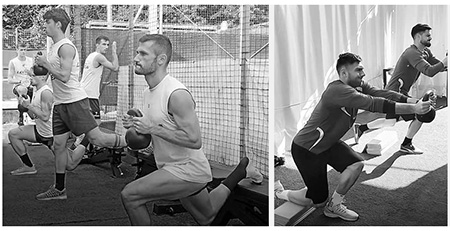
Kettlebell Swing and Zercher Squat
During the off-season, the kettlebell swing and the Zercher squat were performed twice a week. The total load and volume of the swing were increased weekly as long as the athlete maintained proper technique. We also increased the workload of the Zercher squat and, similar to the swing, focused on keeping the repetitions technically sound. During the last week of the off-season, we tested the Zercher squat to find each athlete’s five rep max (5RM).
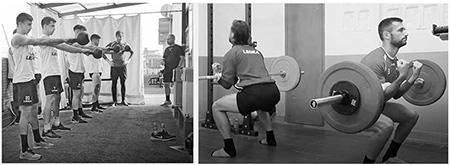
As we approached the competitive in-season, we cut our training sessions down to once a week. In this cycle, the goal was to develop maximum power in the swing and increase maximum strength in the Zercher squat. We increased the swing weight by going up one kettlebell size, while reducing the number of reps. During the first two weeks, we varied the load by alternating sets with different kettlebells. For example, a player who originally used the 16kg kettlebell alternated a set with the 16kg and 20kg, and a player who originally used the 20kg kettlebell did the same with the 24kg. We lowered the volume and increased the intensity (Table 2).
The third week we switched to using the heavier kettlebell for all sets and reps. The intent was to increase the volume while maintaining power in each swing.
In the next cycle, about three months into our program, we raised the training intensity to develop maximum power. To achieve this goal, we used a kettlebell size equal to 1/3 of the athlete’s bodyweight and switched to low reps: 5 every 30 seconds or a given timeframe that changed each session (Table 3).
Once we identified each athlete’s 5RM Zercher squat, we began a step cycle program. The program began with 5 sets of 3 reps with the athlete’s 5RM, which increased one rep each set every two weeks. The rep increase stopped at 5 sets of 5 reps. In week six, we decreased the volume but increased the load by 5kg. We continued to increase the load until the athlete was no longer able to handle the weight or maintain appropriate technique (Table 4).
Contrary to what often happens in this sport, we did not decrease workload, volume, or intensity to account for the competitive commitments of the athletes. Many trainers tend to decrease training programs as important games approach. Instead, we continued our weekly sessions, maintaining our goal of activating the athlete’s central nervous system and building maximal strength and power. Despite the limited time and high strength demands that occur during competition, pausing the weekly training sessions was unnecessary considering the small amount of time required. When each athlete reached the goal of a 125% bodyweight Zercher squat, we transitioned to Easy Strength, a program by Pavel. Easy Strength maintained the athlete’s strength level throughout the season, requiring minimal effort and time. After training the kettlebell swing for about six months, following Fabio Zonin’s advice, we introduced the swing protocol from Pavel’s book, The Quick and the Dead. This plan was chosen to improve the athlete’s maximum power, while avoiding excessive H+ accumulation and soreness during the competitive season.
Building a Strong Upper Body
Following StrongFirst principles, I also proposed a program to strengthen the upper body in addition to the lower limbs. Building muscle mass in the upper body not only increases speed during acceleration but is also valued by players. During the off-season, I proposed two weekly training sessions to be performed before the kettlebell swings and the Zercher squat. The exercises included horizontal and vertical push-and-pull motor patterns. Knowing that many players appreciate visible muscle tone, I also included two exercises for biceps and triceps. The first session of the week included half-kneeling landmine press, pullups, and triceps exercises. The second session included bench press, single-arm kettlebell row, and biceps exercises. The two training sessions are described below.
Session One
Half-Kneeling Landmine Press
After two weeks of training the half-kneeling landmine press, each athlete tested the weight for their 8-9RM. The athletes performed sets of 2-6 reps with this load. Every two sessions we increased the load by 3% stopping when repetitions could not be completed. When an athlete failed to complete the prescribed number of reps or his technique broke down, he stepped back, rested, and started again. The goal was to press a weight equal to 50% of the athlete’s bodyweight.
Pullups
After demonstrating proper technique, we tested the maximum reps of each athlete’s bodyweight pullups. The players who could not perform pullups, completed flexed-arm hangs followed by controlled negatives until they could perform a strict rep. The pullup is an exercise that requires a fair amount of strength. Not everyone can perform the same number of reps or even complete one. Based on the athlete’s maximum reps, we designed personalized programs according to the StrongFirst Fighter Pullup Program.
Session Two
Bench Press
After two weeks of movement preparation and technique training, we tested the athlete’s maximum weight for 7-8 reps with good technique. Using this weight, the players performed 5 sets of 5 reps. Every two sessions the load was increased by 3%, no less than 2.5kg at a time, until all reps were completed. When the athlete failed or his technique broke down, he stepped back, rested, and started again. The intent was for each athlete to complete five reps with a weight equal to his bodyweight.
Single-Arm Kettlebell Row
Following two weeks of technique and movement preparation, we tested each athlete’s single-arm row to find the kettlebell weight for their 7-8RM. Using this load, the players performed sets ranging from 2-6 reps, increasing the volume by two reps every two sessions. During the initial phase, the players performed a supported single-arm row. The goal was to complete all reps with a weight equal to 1/3 of the players’ bodyweight. In the next phase, we increased the technical difficulty, switching from a supported single-arm row to an unsupported one. As we increased technical difficulty, the weight used by the athlete dropped by 15%.
A Revolutionary Training Program
Following StrongFirst training principles and plans, the Renate Calcio team achieved impressive results. Training the Zercher squat once a week with sub-maximal loads raised maximal strength levels and increased each athlete’s 1RM. Within four months, all players reached a 1RM that ranged from 130-160% of their bodyweight. The kettlebell swing proved to be an excellent method to train hip extensor muscles and improve the athletes’ hip hinge patterns. Hip extensor muscle training considerably reduced the rate of injuries. After eight months, we still have not had any cases of injured hamstrings, which is one of the most common injuries among soccer players. The StrongFirst training systems used with this team resulted in an increase of strength and performance levels that did not stress the nervous system or cause physical exhaustion. This was especially apparent by increased athletic performance during the second half of the game when fatigue typically sets in. Renate Calcio began the season as a low-ranking team but impressively finished the season between second and fourth place in the national ranking. The significant results of this program demonstrate that StrongFirst training systems could become a revolutionary program for soccer teams at any level.
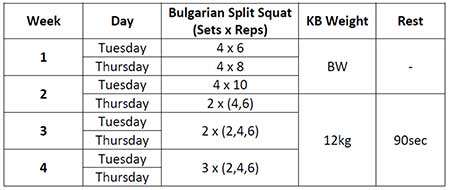
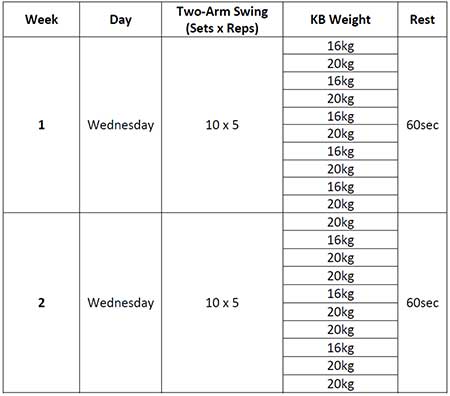

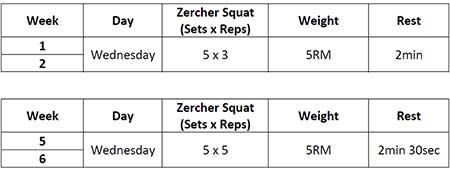
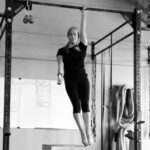
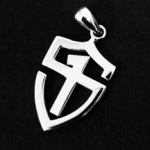
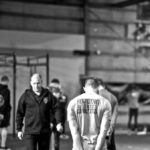
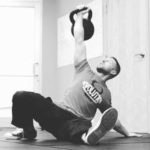
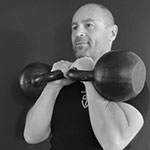

How many sets of rows and landmine press did you do?
Depends, about 6 set with different reps.
When you hit your zercher squat goal and moved to easy strength, what did your easy strength program look like? What exercises / frequency / etc? Or do you mean the easy strength sets and reps criteria with the zercher?
This training will be explained in the next seminar “Programming Improv” that will be held on June 4-5 in Vicenza.
Yes, Easy Strenght it was applied to the training for the Zercher Squat.
Hey Mauro,
very, very interesting article and impressive numbers that your players reached. I was wondering if you could elaborate a little more about how the described numbers transferred to sport specific improvement on the field, such as:
– Did the team score more goals in minutes 75 to 90 compared to the season before?
– Did the players’ top speed on the field improve?
– Did the km run per game improve?
– Were the players able to perform more intensive runs (runs between 20 and 27 kph) per game?
– Due to training of the central nervous system: Did reaction time on the field improve?
Thanks much and greetings from Germany
Christoph
Ciao Christoph, I’ll try to answer you below:
1. I don’t have last year’s data. It’s my first season here. But around 25% of our goals were scored in the last quarter.
2. We did not use this parameter to monitor performance. We refer to the accelerations and decelerations, meters /min running and total meters running over 25 km/h.
3. The distance covered in the game depends on many factors, I can tell you that in general the intensity detected for every 15 min was elevated in many games.
4. This data also varies a lot from game to game. But in general it was high for every athlete.
5. We didn’t do specific tests for the reaction time.
Great article!
I’m a recreational soccer player and train lower body 1x per week
Could I do:
(1) zercher squat 3×5 to 5×5
(2) swings 10×5
(3) split squats
And slowly increase volume and weight over time?
Thank you Jon for your require.
Yes, you can work with this planning.
The volume can be increased by keeping the intensity constant. Then when you decrease the volume and go back to 5×3 you increase the intensity. Take a 1RM test every 3-4 months, to understand what level you have reached. Our goal was to reach 1.25% of BW with 1RM. With the KB work first on the volume, reaching even over 100 hits … then decrease the volume and re-start again. The target will be work with a KB close to 1/3 of the BW.
Thanks!
How would you progress the split squats?
As written in the article in the table 1.
Did you consider zercher bulgarian split squats to replace doing both zercher squats and Bulgarian split squats?
yes, increased the weigth and reduce the volume… than increase that volume with the same intensity. Until you’ll get the desired 1RM or you’ll failled 2 time.